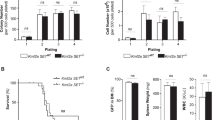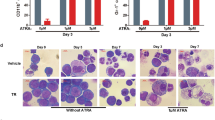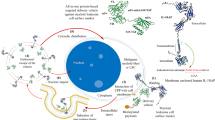Abstract
The translocation t(12;22)(p13;q11) creates an MN1-TEL fusion gene leading to acute myeloid leukemia. MN1 is a transcription coactivator of the retinoic acid and vitamin D receptors, and TEL (ETV6) is a member of the E26-transformation-specific family of transcription factors. In MN1-TEL, the transactivating domains of MN1 are combined with the DNA-binding domain of TEL. We show that MN1-TEL inhibits retinoic acid receptor (RAR)-mediated transcription, counteracts coactivators such as p160 and p300, and acts as a dominant-negative mutant of MN1. Compared to MN1, the same transactivation domains in MN1-TEL are poorly stimulated by p160, p300 or histone deacetylase inhibitors, indicating that the block of RAR-mediated transcription by MN1-TEL is caused by dysfunctional transactivation domains rather than by recruitment of corepressors. The mechanism leading to myeloid leukemia in t(12;22) thus differs from the translocations that involve RAR itself.
This is a preview of subscription content, access via your institution
Access options
Subscribe to this journal
Receive 50 print issues and online access
$259.00 per year
only $5.18 per issue
Buy this article
- Purchase on SpringerLink
- Instant access to full article PDF
Prices may be subject to local taxes which are calculated during checkout






Similar content being viewed by others
References
Bailly RA, Bosselut R, Zucman J, Cormier F, Delattre O, Roussel M et al. (1994). DNA-binding and transcriptional activation properties of the EWS-FLI-1 fusion protein resulting from the t(11;22) translocation in Ewing sarcoma. Mol Cell Biol 14: 3230–3241.
Beverloo HB, Panagopoulos I, Isaksson M, van Wering E, van Drunen E, de Klein A et al. (2001). Fusion of the Homeobox gene HLXB9 and the ETV6 gene in infant acute myeloid leukemias with the t(7;12)(q36;p13). Cancer Res 61: 5374–5377.
Boer J, Bonten-Surtel J, Grosveld G . (1998). Overexpression of the nucleoporin CAN/NUP214 induces growth arrest, nucleocytoplasmic transport defects, and apoptosis. Mol Cell Biol 18: 1236–1247.
Bohlander SK . (2005). ETV6: a versatile player in leukemogenesis. Semin Cancer Biol 15: 162–174.
Braun BS, Frieden R, Lessnick SL, May WA, Denny CT . (1995). Identification of target genes for the Ewing's sarcoma EWS/FLI fusion protein by representational difference analysis. Mol Cell Biol 15: 4623–4630.
Buijs A, Sherr S, van Baal S, van Bezouw S, van der Plas D, Geurts Van Kessel A et al. (1995). Translocation (12;22) (p13;q11) in myeloproliferative disorders results in fusion of the ETS-like TEL gene on 12p13 to the MN1 gene on 22q11 [published erratum appears in Oncogene 1995 Aug 17;11(4):809]. Oncogene 10: 1511–1519.
Buijs A, van Rompaey L, Molijn AC, Davis JN, Vertegaal AC, Potter MD et al. (2000). The MN1-TEL fusion protein, encoded by the translocation (12;22)(p13;q11) in myeloid leukemia, is a transcription factor with transforming activity. Mol Cell Biol 20: 9281–9293.
Carella C, Bonten J, Rehg J, Grosveld GC . (2006). MN1-TEL, the product of the t(12;22) in human myeloid leukemia, immortalizes murine myeloid cells and causes myeloid malignancy in mice. Leukemia 20: 1582–1592.
Cazzaniga G, Daniotti M, Tosi S, Giudici G, Aloisi A, Pogliani E et al. (2001). The paired box domain gene PAX5 is fused to ETV6/TEL in an acute lymphoblastic leukemia case. Cancer Res 61: 4666–4670.
Chakrabarti SR, Nucifora G . (1999). The leukemia-associated gene TEL encodes a transcription repressor which associates with SMRT and mSin3A. Biochem Biophys Res Commun 264: 871–877.
Goodman RH, Smolik S . (2000). CBP/p300 in cell growth, transformation, and development. Genes Dev 14: 1553–1577.
Gossen M, Bujard H . (1992). Tight control of gene expression in mammalian cells by tetracycline-responsive promoters. Proc Natl Acad Sci USA 89: 5547–5551.
Guidez F, Ivins S, Zhu J, Soderstrom M, Waxman S, Zelent A . (1998). Reduced retinoic acid-sensitivities of nuclear receptor corepressor binding to PML- and PLZF-RARalpha underlie molecular pathogenesis and treatment of acute promyelocytic leukemia. Blood 91: 2634–2642.
Gunther CV, Nye JA, Bryner RS, Graves BJ . (1990). Sequence-specific DNA binding of the proto-oncoprotein ets-1 defines a transcriptional activator sequence within the long terminal repeat of the Moloney murine sarcoma virus. Genes Dev 4: 667–679.
Heinzel T, Lavinsky RM, Mullen TM, Soderstrom M, Laherty CD, Torchia J et al. (1997). A complex containing N-CoR, mSin3 and histone deacetylase mediates transcriptional repression [see comments]. Nature 387: 43–48.
Hisa T, Spence SE, Rachel RA, Fujita M, Nakamura T, Ward JM et al. (2004). Hematopoietic, angiogenic and eye defects in Meis1 mutant animals. EMBO J 23: 450–459.
Kawagoe H, Grosveld GC . (2005). Conditional MN1-TEL knock-in mice develop acute myeloid leukemia in conjunction with overexpression of HOXA9. Blood 106: 4269–4277.
Leo C, Chen JD . (2000). The SRC family of nuclear receptor coactivators. Gene 245: 1–11.
Meester-Smoor MA, Vermeij M, Van Helmond MJL, Molijn AC, Van Wely KHM, Hekman ACP et al. (2005). Targeted disruption of the Mn1 oncogene results in severe defects in development of membranous bones of the cranial skeleton. Mol Cell Biol 25: 4229–4236.
Mercader N, Leonardo E, Piedra ME, Martinez AC, Ros MA, Torres M . (2000). Opposing RA and FGF signals control proximodistal vertebrate limb development through regulation of Meis genes. Development 127: 3961–3970.
Pattyn F, Speleman F, De Paepe A, Vandesompele J . (2003). RTPrimerDB: the real-time PCR primer and probe database. Nucleic Acids Res 31: 122–123.
Perissi V, Staszewski LM, McInerney EM, Kurokawa R, Krones A, Rose DW et al. (1999). Molecular determinants of nuclear receptor–corepressor interaction. Genes Dev 13: 3198–3208.
Sutton AL, Zhang X, Ellison TI, Macdonald PN . (2005). The 1,25(OH)2D3-regulated transcription factor MN1 stimulates vitamin D receptor-mediated transcription and inhibits osteoblastic cell proliferation. Mol Endocrinol 19: 2234–2244.
Van Roozendaal KE, Darling D, Farzaneh F . (1990). DMSO and retinoic acid induce HL-60 differentiation by different but converging pathways. Exp Cell Res 190: 137–140.
van Wely KH, Molijn AC, Buijs A, Meester-Smoor MA, Aarnoudse AJ, Hellemons A et al. (2003). The MN1 oncoprotein synergizes with coactivators RAC3 and p300 in RAR-RXR-mediated transcription. Oncogene 22: 699–709.
Vivanco Ruiz MM, Bugge TH, Hirschmann P, Stunnenberg HG . (1991). Functional characterization of a natural retinoic acid responsive element. EMBO J 10: 3829–3838.
Wan YJ, Cai Y, Magee TR . (1998). Retinoic acid differentially regulates retinoic acid receptor-mediated pathways in the Hep3B cell line. Exp Cell Res 238: 241–247.
Wang ZG, Delva L, Gaboli M, Rivi R, Giorgio M, Cordon-Cardo C et al. (1998). Role of PML in cell growth and the retinoic acid pathway. Science 279: 1547–1551.
Yoshida M, Kijima M, Akita M, Beppu T . (1990). Potent and specific inhibition of mammalian histone deacetylase both in vivo and in vitro by trichostatin A. J Biol Chem 265: 17174–17179.
Acknowledgements
We thank Drs D Chen and R Eckner for permission to use RAC3 and p300 expression constructs, and E Korpershoek for providing POLR2A primers. This work was supported by Dutch Cancer Society Grants EUR 94-653 and 98-1778 and NCI Grant CA72999. KvW is supported by grant RyC-2004-1886 from the Spanish Ministry of Education and Science.
Author information
Authors and Affiliations
Corresponding author
Rights and permissions
About this article
Cite this article
van Wely, K., Meester-Smoor, M., Janssen, M. et al. The MN1-TEL myeloid leukemia-associated fusion protein has a dominant-negative effect on RAR-RXR-mediated transcription. Oncogene 26, 5733–5740 (2007). https://doi.org/10.1038/sj.onc.1210382
Received:
Revised:
Accepted:
Published:
Issue date:
DOI: https://doi.org/10.1038/sj.onc.1210382



